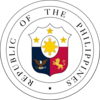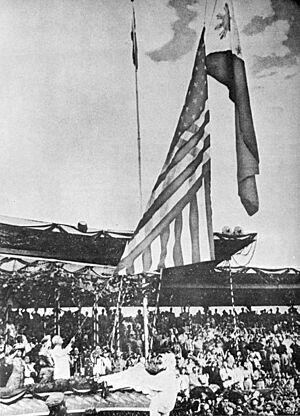History of the Philippines (1946–1965) facts for kids
Quick facts for kids
Republic of the Philippines
|
|||||||||
|---|---|---|---|---|---|---|---|---|---|
| 1946–1965 | |||||||||
|
|
|||||||||
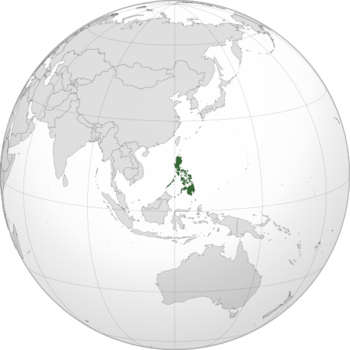
Location of the Philippines in Southeast Asia.
|
|||||||||
| Capital | Manila (before 1948) Quezon City (after 1948) |
||||||||
| Largest city | Manila | ||||||||
| Official languages | Filipino Spanish English |
||||||||
| Spoken languages | See Languages of the Philippines | ||||||||
| Religion | Catholicism Protestantism Islam |
||||||||
| Government | Unitary presidential constitutional republic | ||||||||
| President | |||||||||
|
• 1946–1948
|
Manuel Roxas | ||||||||
|
• 1948–1953
|
Elpidio Quirino | ||||||||
|
• 1953–1957
|
Ramon Magsaysay | ||||||||
| Vice President | |||||||||
|
• 1946–1948
|
Elpidio Quirino | ||||||||
|
• 1949–1953
|
Fernando Lopez | ||||||||
|
• 1953–1957
|
Carlos P. Garcia | ||||||||
|
• 1957–1961
|
Diosdado Macapagal | ||||||||
|
• 1961–1965
|
Emmanuel Pelaez | ||||||||
| Legislature | Congress | ||||||||
| Senate | |||||||||
| House of Representatives | |||||||||
| History | |||||||||
|
• Treaty of Manila
|
July 4, 1946 | ||||||||
| July 4, 1946 | |||||||||
| April 17, 1948 | |||||||||
| December 30, 1953 | |||||||||
|
• 1957 Cebu Douglas C-47 crash
|
March 17, 1957 | ||||||||
|
• Inauguration of Carlos P. Garcia
|
March 18, 1957 | ||||||||
| December 30, 1961 | |||||||||
|
• Inauguration of Ferdinand Marcos
|
December 30, 1965 | ||||||||
| Currency | Philippine peso (₱) | ||||||||
| Time zone | UTC+08:00 (PST) | ||||||||
| Date format |
|
||||||||
| Driving side | right | ||||||||
| ISO 3166 code | PH | ||||||||
|
|||||||||
| Today part of | Philippines | ||||||||
The Philippines became an independent country in 1946. This article tells the story of the Philippines from that time until 1965. This period is often called the Third Republic of the Philippines. It was a time when the country was building itself up after World War II.
Contents
Becoming an Independent Nation
The United States officially granted independence to the Philippines on July 4, 1946. This was done through a special law called the "Tydings–McDuffie Act". President Harry S. Truman made it official with Proclamation 2695.
On the same day, the United States and the Philippines signed a treaty. This treaty recognized the Philippines as an independent republic. It also meant the U.S. gave up its control over the Philippine Islands.
However, the U.S. kept many military bases in the Philippines. Also, the U.S. Congress passed a law called the Bell Trade Act. This law allowed the U.S. to limit imports from the Philippines if they competed with American products. It also gave U.S. citizens and companies special access to Philippine natural resources.
The Philippines had to accept these terms. The U.S. was threatening to hold back money needed to rebuild the country after World War II. So, the Philippine Congress agreed to the Bell Act on July 2, 1946.
When is Independence Day?
The Philippines now celebrates its Independence Day on June 12. This date marks when Emilio Aguinaldo declared independence from Spain in 1899. The United States did not recognize this declaration at the time.
From 1946 to 1961, the Philippines celebrated Independence Day on July 4. On May 12, 1962, President Macapagal changed the date to June 12. In 1964, a law officially moved Independence Day to June 12. The July 4 holiday was then renamed Philippine Republic Day.
The Roxas Presidency (1946–1948)
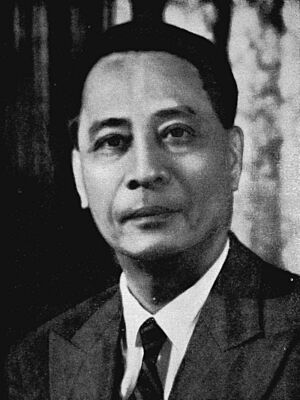
In 1946, Manuel Roxas ran for president. He was supported by General MacArthur. Roxas won the election and became the first president of the new republic on July 4, 1946.
Roxas successfully got money from the United States to help rebuild the country. But he had to agree to some conditions. These included allowing the U.S. to lease 23 military bases for 99 years. There were also trade limits for Filipinos and special benefits for U.S. businesses.
His time in office faced challenges. There were problems with corruption. Also, the military police sometimes abused their power. This led to the rise of a group called the Hukbalahap (Huk) movement. This group was made up of unhappy farmers. Roxas tried to stop the Huks, but this made many farmers even more upset.
During Roxas's term, the Turtle Islands and Mangsee Islands were transferred to the Philippines. These islands had been managed by the United Kingdom. The transfer became official on October 16, 1947.
President Roxas died of a heart attack on April 15, 1948. He was giving a speech at Clark Air Base. His vice president, Elpidio Quirino, took over as president.
The Quirino Presidency (1948–1953)
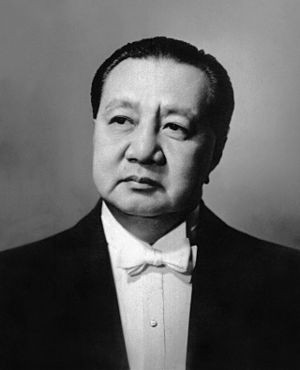
Elpidio Quirino became president on April 17, 1948. He took his oath of office two days after President Roxas passed away. In the 1949 election, Quirino ran against Jose P. Laurel. Quirino won, though some historians believe the election had problems.
Since Quirino was a widower, his daughter, Vicky, served as the official hostess. She performed the duties usually done by the First Lady.
Quirino's government faced a big challenge from the Hukbalahap movement. The Huks were originally a group that fought against the Japanese during the war. But now, their leaders were communists. When talks between Quirino and Huk leader Luis Taruc failed in 1948, Taruc called for the government to be overthrown.
Quirino's five years as president saw a lot of rebuilding after the war. The economy grew, and the U.S. gave more financial help. However, basic problems in rural areas remained unsolved. His administration also faced issues with corruption.
In 1953, during his second term, the Korean War began. The Philippines sent over 7,450 soldiers to Korea. This group was called the Philippine Expeditionary Forces to Korea (PEFTOK).
Quirino ran for re-election in 1953, even though he was ill. But he lost by a large margin to Ramon Magsaysay.
The Magsaysay Presidency (1953–1957)
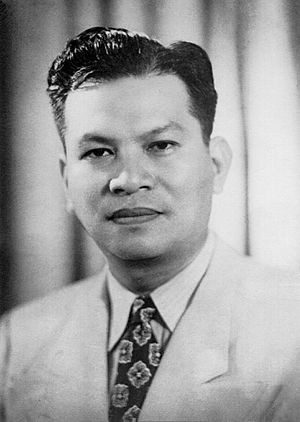
In the 1953 election, Ramon Magsaysay was elected president. He had help from American officials and funds. He wore the Barong Tagalog when he took his oath of office. This was the first time a Philippine president did so.
As president, Magsaysay was a strong friend of the United States. He spoke out against communism during the Cold War. He helped create the Southeast Asia Treaty Organization (SEATO) in 1954. This group aimed to stop communist movements in Southeast Asia.
Magsaysay was known for being close to the people. He opened the doors of Malacañang Palace, the presidential residence, to the public. He even paid for his own flight on a new PAF plane. He wanted to show his honesty.
On March 16, 1957, Magsaysay flew to Cebu City. He spoke at three schools there. Early the next morning, March 17, his plane, "Mt. Pinatubo," went missing. Later that day, news reported that the plane had crashed on Mount Manunggal in Cebu. Twenty-five of the 26 people on board died. Only a newspaperman named Nestor Mata survived.
Vice President Carlos P. Garcia was in Australia at the time. He returned and became president to finish Magsaysay's term. About 2 million people attended Magsaysay's burial on March 22, 1957.
The Garcia Presidency (1957–1961)
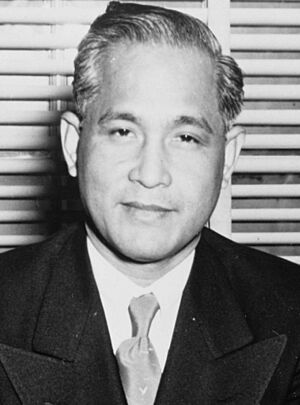
Carlos P. Garcia became president after Ramon Magsaysay's plane crash on March 17, 1957. Later that year, Garcia was elected to a full term as president.
During his time in office, he worked on the Bohlen–Serrano Agreement. This agreement shortened the lease of U.S. military bases from 99 years to 25 years. It also made the lease renewable every five years.
Garcia was well-known for his "Filipino First policy." This policy aimed to help Filipino business owners more than foreign investors. He also made changes to retail trade that affected Chinese business owners in the country. He also started a program to encourage thriftiness among Filipinos.
At the end of his term, he ran for re-election in 1961. But he was defeated by Diosdado Macapagal. Macapagal was his vice-president but belonged to a different political party. In the Philippines, the president and vice-president are elected separately.
The Macapagal Presidency (1961–1965)
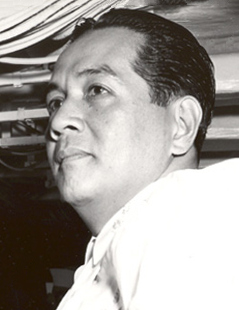
In the 1961 presidential election, Diosdado Macapagal ran against Garcia. He defeated the current president with 55% of the votes. Macapagal wanted to help the economy grow. He allowed the Philippine peso to be traded freely in the currency market.
His efforts to make reforms were sometimes blocked by the Nacionalista Party. This party had more members in the House of Representatives and the Senate. Despite this, his presidency brought growth and good times for the nation.
One of Macapagal's most important achievements was the Agricultural Land Reform Code of 1963. This law aimed to end the system where farmers rented land from landowners. It helped farmers own their own land.
He also changed the date of Philippine independence from July 4 to June 12. June 12 was the day in 1898 when Emilio Aguinaldo declared independence from Spain. Macapagal later said he made the change because American Independence Day celebrations on July 4 were more popular than Filipino ones.
Macapagal ran for re-election in 1965 but lost. He was defeated by Ferdinand Marcos. Marcos was a former ally from Macapagal's own party who switched to the Nacionalista Party to challenge him.




